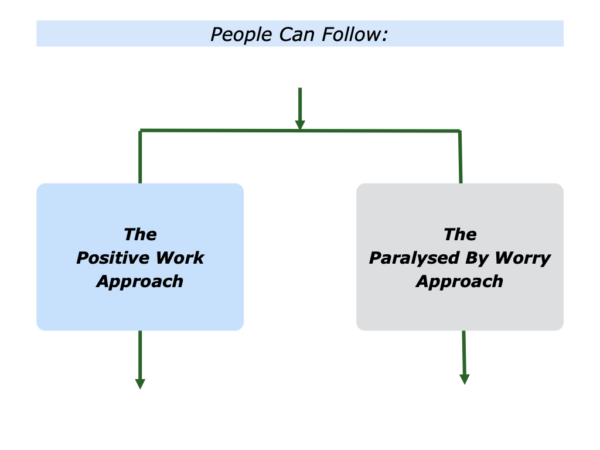
There are many ways to live life. Some people choose to follow the positive work approach rather than the paralysed by worry approach. They aim to do work that helps people to shape a positive future.
Different people follow this route in different ways. Some aim to build on their personal strengths, follow certain principles and do work that helps people or the planet.
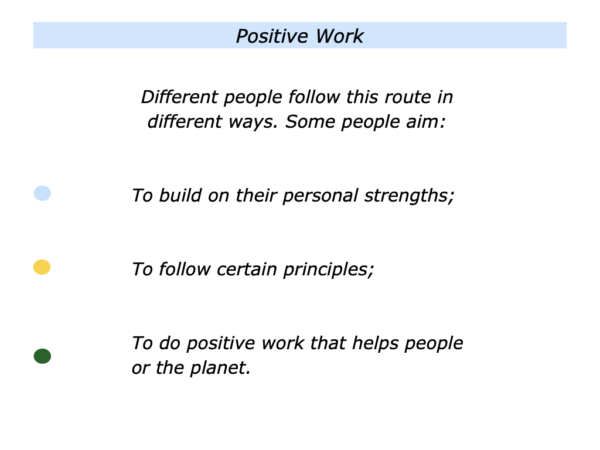
Different people have different reasons for following this route. Some may have had parents, teachers or other significant people who encouraged them to take this approach.
Some may reach a point in their lives where they decide to do positive work rather than be paralysed by worry. This is a path sometimes taken by people who are highly sensitive. One person expressed this in the following way.
“I am a person who is very open to influences around me. There was a point in my life when I was addicted to consuming bad news. This did not help anyone. Looking ahead, I realised that I had a choice.
“The first option was to spend my life paralysed by fear. This is a tactic often used by authority figures who want to make people feel impotent and it can lead to despair.
“The second option was to have a positive attitude. It was to focus what I could control rather than what I could not control. I chose to build on my strengths and do my best to help people in my life and work.”
Different people choose different ways to translate the positive work approach into action. Some focus on the following themes.
Personal Strengths
Some people build on their personal strengths and do things that give them positive energy. They translate this into doing work that helps people or the planet. Let’s look at some examples.
Dame Cecily Saunders translated her compassion into helping to found the modern hospice movement. Maria Montessori translated her passion for education into helping children and founding the Montessori Schools approach.
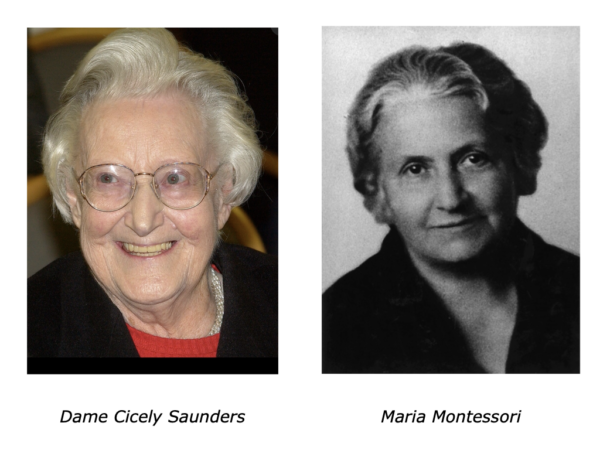
Principles
Some people believe in following certain principles. They may take this approach when working as a medic, craft worker, artist, scientist, leader or in another role.
John Wooden, the great basketball coach, encouraged his players to follow certain principles and become the best they could be. The players who followed this approach were more likely to find peace of mind.
Nelson Mandela encouraged people to see others as human beings and to build on what they had in common. People who followed these principles were more likely to find solutions that benefited both them and their society.
Positive Work
Some people aim to build on their personal strengths, follow their principles and do their best to get positive results. They aim to do work that helps people or the planet. Let’s look at examples of people who took this route.
Bronnie Ware – Learning
From People Who Are Dying
Bronnie’s life changed when she worked in palliative care. She found that many people experienced a sense of peace before they died. Learning from them, she discovered that some had regrets.
She found these often followed certain themes. Bronnie began writing about these themes in a blog, which she later expanded into a book. Here are some excerpts from her work.
For many years I worked in palliative care. My patients were those who had gone home to die. Some incredibly special times were shared. I was with them for the last 3 to 12 weeks of their lives.
People grow a lot when they are faced with their own mortality. I learnt never to underestimate someone’s capacity for growth.
Some changes were phenomenal. Each experienced a variety of emotions, as expected, denial, fear, anger, remorse, more denial and eventually acceptance. Every single patient found their peace before they departed though, every one of them.
When questioned about any regrets they had or anything they would do differently, common themes surfaced again and again. Here are the most common five.
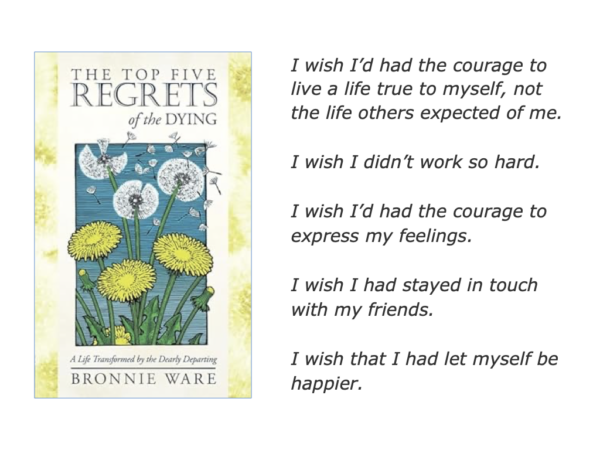
When you are on your deathbed, what others think of you is a long way from your mind. How wonderful to be able to let go and smile again, long before you are dying.
Life is a choice. Choose consciously, choose wisely, choose honestly. Choose happiness.
Dr Govindappa Venkataswamy
– Giving People The Gift Of Sight
Known as Dr V, Govindappa Venkataswamy dedicated his life to providing people with the gift of sight. His individual work and the founding of the Aravind Eye Hospitals has led to helping millions of people to see. He believed in the following philosophy.
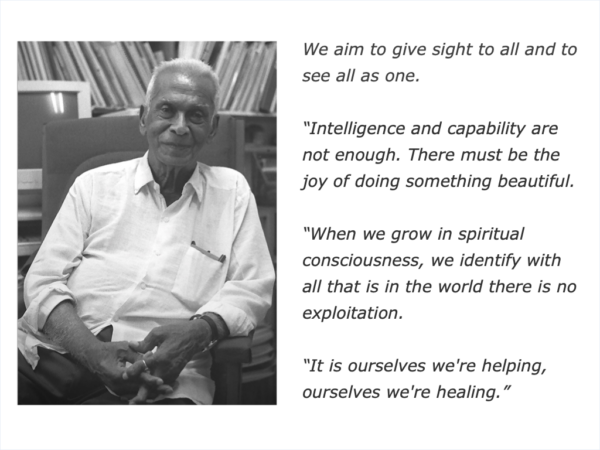
Here is an introduction to Dr V’s work. This is based on an article by David Kemer in which he cites the doctor as his hero.
Dr V. was born in 1918 to a farming family in South India. He gained a medical degree, planned to practice obstetrics but then experienced a setback. Contracting rheumatoid arthritis which affected his hands, he decided to change field. David Kemer describes what Dr V. did next.
He began studying ophthalmology and had instruments specially designed for his arthritic hands – each one custom-made to fill a specific need.
These instruments enabled him to perform as many as 100 cataract surgeries a day. He quickly became the most admired cataract surgeon in India.
Dr V. performed eye surgeries at this rate for 25 years before exploring how to scale his approach. Inspired by the McDonald’s approach to selling burgers, he aimed to provide millions of sight-restoring operations.
This led to setting up the Aravind Eye Hospital. This had 11 beds in a rented house in Madurai, India. David Kemer describes what has happened since.
Today, there are some 3600 beds in five Aravind Eye Hospitals that perform more than 200,000 operations each year. And 70% of the patients pay little or nothing.
Hundreds of thousands of India’s poor have been granted the gift of sight. Dr V. lowered the cost of cataract operations to nearly $10 per surgery compared to almost $1650 in the U.S.
He reorganized how cataract surgeries are done. By training a team of paramedicals to do 70% of the work required in each surgery, doctors are freed up to do a great many more of them.
All of the treatments performed at Aravind Eye Hospitals are financed by those patients who are most able to afford them – roughly 30% – who seek out Aravind’s world-renowned quality and happily pay competitive prices.
As such, Aravind Hospitals have become a business model for health care systems the world over.
E.F. Schumacher – Small Is Beautiful
Fritz Schumacher is best known for his book Small Is Beautiful. He believed that economics should serve people rather than the other way round. The aim of societies should be to enable people:
“To obtain the maximum amount of well-being with the minimum amount of consumption.”
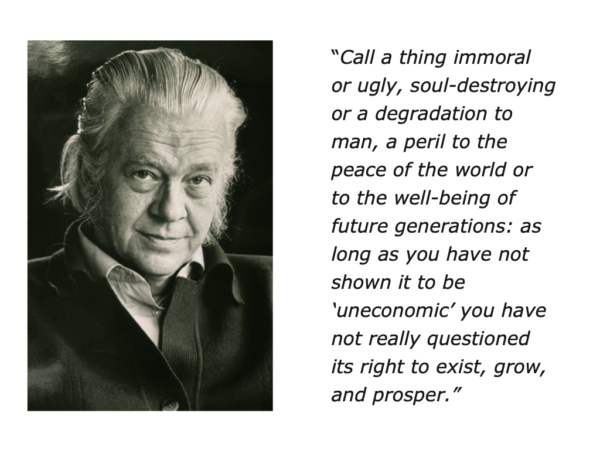
Background
Ernst Friedrich Schumacher was born in Germany in 1911. He studied as a Rhodes Scholar at Oxford before settling in England in 1936.
After the Second World Way he acted as an economic advisor to organisations helping to rebuild the German economy. He then became Chief Economic Advisor to the British Coal Board, a post he held between 1950 and 1970.
Despite playing a key role in shaping British industry, Fritz began exploring alternative models. During the 1950s he acted as an economic advisor to countries in Asia.
This led to him developing what he called Buddhist Economics. The principles he espoused included:
That good work plays a vital part in healthy human development;
That developing local resources for local needs is the most rational way of economic life;
That it is possible to empower local communities to employ appropriate technology they can use to shape their futures.
These ideas need to be seen in relation to the economic beliefs prevalent from the 1950s onwards – the belief that bigness was best. This led to building bigger schools, hospitals, factories, institutions, aid programmes and government departments.
Such an approach produced some upsides, but there were also downsides. Bureaucrats controlling the levers of power were further away from the effects of their decisions.
Small Is Beautiful
Writing in Alias Papa, Fritz’s eldest daughter Barbara Wood says he made a key decision in 1970. He left full time work with the Coal Board to write the books that had been in his mind for years.
He wrote Small Is Beautiful, which was published in 1973. The book would have a remarkable effect on people for several generations. More than thirty years later, Kamran Mofid would describe the book in the following way.
Schumacher’s Small is Beautiful is an appeal to the deep instinctive understanding of the common good that all people share.
It is an appeal to our essential humanity. It deals with some of the most pressing concerns of people the world over, concerns which every generation must consider and answer.
The book encourages us to reflect on and understand things we seem to have forgotten: What is Education? What is Knowledge? What is Wisdom? What is the source of happiness and wellbeing?
What is the good life? What is the purpose of economic life? What does it mean to be a human being living on a spaceship with finite resources?
The remedy he proposed – a holistic approach to human society, which stressed small scale, localised solutions – flew in the face of economic orthodoxies of the time.
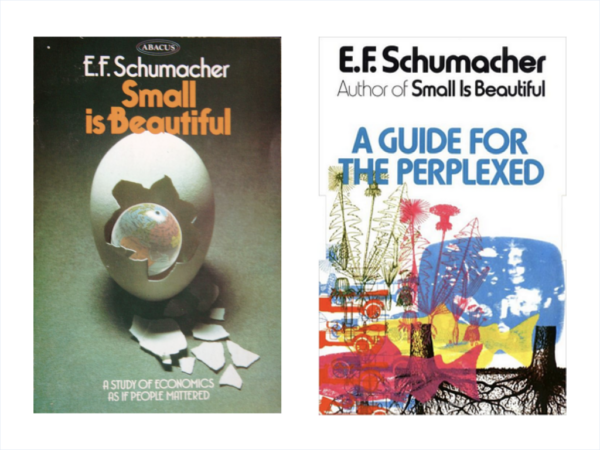
The Role Of Work
Fritz believed work had a three-fold purpose:
To provide people with useful goods and services; To provide people with the chance to use and perfect their gifts; To provide people with the chance to collaborate with others in order to liberate themselves from inbuilt egocentricity.
Ever the practitioner, Fritz began translating his ideas into action. This led to creating The Intermediate Technology Group. This enabled local communities to employ the appropriate technology to meet their needs.
The Role of Education
Fritz believed education could play a key role in enabling people to develop wisdom. Unfortunately, he said, modern education has become atomised.
Education should instead enable people to connect with the key issues of life – such as how they could be truly healthy and happy. He said that it should help people:
To act as spiritual beings; To act as neighbours and to render service; To act as responsible people; To be creatively engaged, using and developing the gifts that they had been blessed with.
Fritz believed it was vital to be true to the spirit of the Earth that has given us life. The danger was that we would become disconnected. Therefore we needed to recognise what was truly important in life.
Writing in A Guide For The Perplexed, he explained this in the following way.
The generosity of the Earth allows us to feed all mankind. We know enough about ecology to keep the Earth a healthy place; there is enough room on the Earth, and there are enough materials, so that everybody can have adequate shelter.
We are quite competent enough to produce sufficient supplies of necessities so that no one need live in misery.
There are many ways to live life. Some people aim to do positive work that helps people or the planet. Different people follow this route in different ways.
Some do it in their daily lives. They aim to encourage their loved ones, friends and colleagues. Some aim to do it in their work as educators, medics, craft workers, scientists, leaders or in other roles.
Imagine you want to follow elements of this approach. How can you do this in your own way? How can you build on your personal strengths, follow your principles and do positive work?
If you wish, try tackling the exercise on this theme. This invites you to complete the following sentences.
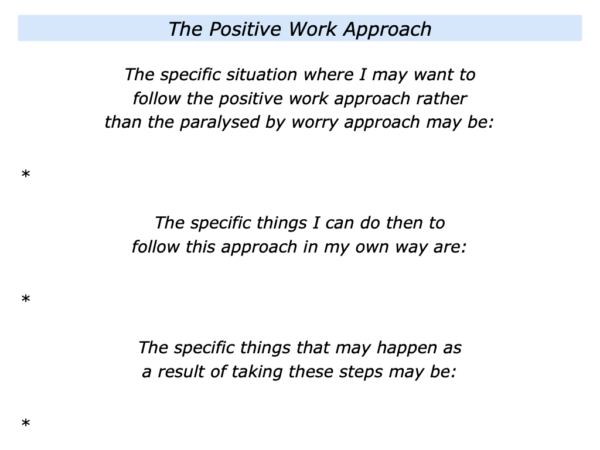


Leave a Reply